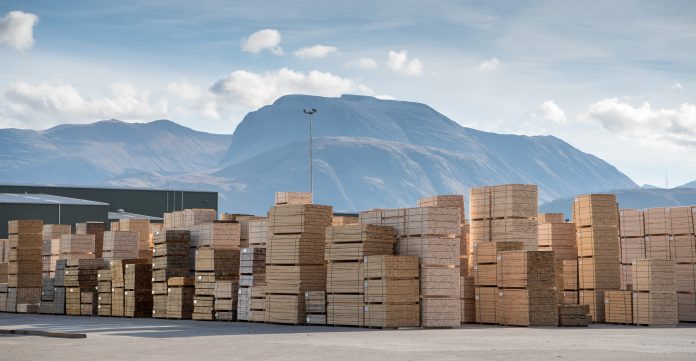Alex Goodfellow, chairman of the Confederation of Timber Industries, examines the barriers to expanding timber use in UK construction and the policy solutions available to the government to address them
Built environment emissions are a major cause for concern, directly accounting for around 25% of the UK’s total carbon output.
Tackling these emissions is essential if we are to hit net zero targets. Using wood instead of other materials in construction can reduce these emissions through the carbon captured and stored in the wood product and the avoidance of using alternative CO2-intensive materials.
This has been recognised by the UK government, who have set up the Timber in Construction Working Group to outline a roadmap to increased timber use in construction by the end of this year.
In the All-Party Parliamentary Group for the Timber Industries’ latest report – Timber Construction: Barriers and Solutions – we look to assist the government’s work, outlining how we can safely and effectively expand low-carbon timber construction in the UK.
The report is structured around key policy themes identified by the timber industry, which are demand, supply, building safety and labour/skills.
Below I provide a whistle-stop tour of the report, outlining the core themes and industry recommendations.
Demand: Increasing the UK’s low-carbon manufacturing capacity
Timber frame is currently underutilised in England, where just 9% of homes are built using wood. This is due to several reasons, including misconceptions over building safety and price, as well as the volatility of the housing market, which attaches high risk to new investment.
In the report, we argue the government can incentivise timber demand through:
- Regulation of embodied carbon emissions, which would inherently incentivise the use of timber, which has the lowest embodied carbon of all the mainstream construction materials. Similar legislation has been seen across Europe in recent years, including in France, the Netherlands and Denmark.
- Linking ambitious affordable housebuilding programmes across the country to low-carbon MMC housing. This would create the continuity of demand required for more private investment into low-carbon manufacturing, research and development.
- Viewing timber construction within the context of a green industrial strategy. Investing in this supply chain will assist in decarbonising construction, promoting forest growth (both domestic and international) and levelling up the UK.
Supply: Strengthening our supply chain resilience
Timber supply is not currently an issue, with more than enough wood in the market to satisfy demand and room for growth. However, there are potential supply risks in the long term, with high international demand and limited domestic supply likely to squeeze the UK timber market.
We argue the UK government can improve timber supply chain resilience by:
- Increasing UK timber production by streamlining the tree-planting process and adopting clear woodland planting targets. This has been seen to great effect in Scotland, where projects validated since 2019 have created 9,381 hectares of woodland.
- Continue importing sustainable timber. Increasing UK supply should be incentivised to complement, rather than replace, imported timber as UK supply alone cannot match demand, even in the medium/long term. Wood from countries like Sweden and Finland is essential if we are to scale up timber construction.
Building safety: Demystifying the use of timber in construction
The government should recognise the nuance of timber systems, distinguishing between (a) structural timber and cladding and (b) high-rise mass timber systems and low-to medium-rise lightweight timber frame.
Failure to distinguish high-rise mass timber from low/mid-rise lightweight timber frame systems is leading to regulation that is not proportional to the risk profile of the building, or the evidence which supports their use.
The government should also recognise timber as a safe building material given the significant amount of industry research and testing that has been undertaken to ensure the safety of timber frame and mass timber systems.
The timber industry has created a wealth of resources to understand timber fire performance, such as timberfiresafety.org and the Timber Accelerator Hub.
Labour & skills: Creating jobs in the low-carbon economy
The CITB estimates that an extra 350,000 full-time workers will be needed in construction by 2028 to deliver net zero targets for the built environment by 2050.
These shortages are particularly prevalent in the timber sector, spanning the whole spectrum of jobs from architects and engineers to carpenters and joiners.
The government can address construction skills shortages in the short term by:
- Championing timber MMC, which in an era of labour shortages will prove invaluable in plugging the chronic skills gaps in the economy. Offsite timber systems are far less labour-intensive than traditional methods of construction, requiring roughly 70% less labour onsite.
And in the long term by:
- Scaling up Design and Technology (DT), with a core focus on sustainable materials like timber to increase interest and uptake in practical skills professions.
- Incentivising timber courses like NMITE’s Timber TED, which has proven successful in recent years. More courses like this will go a long way in increasing future labour supply.
- Reforming the Apprenticeship Levy to include short courses would provide further funds for timber companies to train workers and increase the timber skills base.
This latest report, we hope, will inspire the government and other parties in their bids to formulate green built environment policies for the next election.
I encourage those interested in net zero, the built environment and timber to read the full report via the CTI website. The report can be accessed here.
Alex Goodfellow
Chair
Confederation of Timber Industries

















